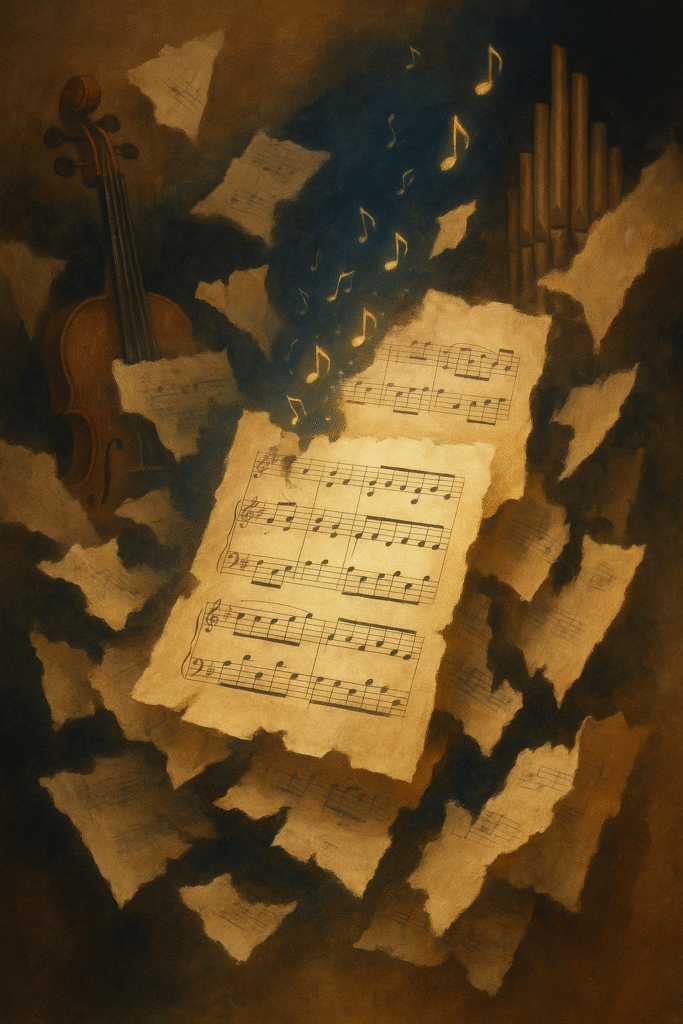
ChatGPT:
Reconstructing Lost Music: The Art and Science of Bringing the Past to Life
This Gresham College lecture by Professor David J. Rau explores the challenges and methodologies involved in reconstructing lost or fragmentary musical works. He discusses historical case studies, modern technologies, and philosophical questions about authenticity and creativity in reconstructing music from incomplete sources.
Conclusion
The lecture illustrates that reconstructing lost music is a multidisciplinary process combining historical research, stylistic analysis, and sometimes imaginative inference. Examples like Mozart’s Requiem, Bach’s St Mark Passion, and incomplete medieval works highlight the complexity of deciding where scholarship ends and speculation begins. Advances in digital tools and artificial intelligence have opened new possibilities but also raised debates about the boundaries of authenticity. Ultimately, Rau argues that reconstruction can both preserve cultural heritage and enrich contemporary creativity, provided its speculative elements are clearly acknowledged. The lecture ends by emphasizing the importance of transparency and humility in such reconstructions, recognizing they can never fully replace the original artistic intentions.
Key Points
🎼 Mozart’s Requiem: The famous Süssmayr completion is both indispensable and controversial due to its hybrid authorship.
🪧 Bach’s St Mark Passion: A lost work reconstructed by combining known texts and musical borrowing from other Bach compositions.
🧩 Historical Sources: Surviving fragments, such as sketches or partial scores, are cross-referenced with contemporaneous works to infer missing material.
🤖 Digital Reconstruction: AI tools and machine learning increasingly assist in stylistic analysis and hypothesizing lost passages.
📜 Authenticity Debate: Reconstructed works often blur the line between historical accuracy and modern interpretation.
🖋️ Editorial Transparency: Scholars stress that editions must distinguish between original material and reconstructions.
🌍 Cultural Value: Reconstructed music allows audiences to connect with lost traditions and understand evolving musical languages.
🔍 Case Study—Ockeghem: Reconstructing medieval polyphony relies on extrapolating from limited notational conventions.
💡 Creativity and Scholarship: The process demands both rigorous method and imaginative empathy with historical composers.
🎤 Public Engagement: Performances of reconstructions provoke reflection on what it means to hear “authentic” music.
Summary
- Introduction to Lost Music
Professor Rau defines “lost music” as works with incomplete or vanished sources and outlines why reconstructing them is essential for cultural heritage. - Mozart’s Requiem Completion
Süssmayr’s role in completing the Requiem has sparked centuries of debate about the legitimacy of finishing another composer’s work. - Bach’s St Mark Passion Reimagined
Scholars have reconstructed this Passion by matching known libretti with existing Bach music and stylistic parallels. - Medieval Challenges
In the Renaissance and medieval periods, fragmentary notation and unwritten performance practice create special difficulties for reconstructions. - Modern Technologies in Reconstruction
Digital imaging, machine learning, and AI are reshaping how musicologists approach lost compositions. - Authenticity Versus Interpretation
Rau emphasizes the philosophical tension between faithfulness to a composer’s intent and creative reconstruction. - Transparency in Editions
Modern critical editions clearly mark reconstructed passages, maintaining scholarly integrity. - Examples Beyond the Canon
The lecture includes less-known examples, such as French Baroque opera fragments and early liturgical chants. - Reconstruction as Cultural Dialogue
Performing reconstructed music can stimulate reflection on how cultural memory is preserved and reshaped. - Conclusion and Reflection
Rau closes by urging humility, transparency, and respect for the limits of what reconstructions can claim to represent.
FAQs about the lecture “Reconstructing Lost Music”:
What is musical reconstruction?
Musical reconstruction is the process of restoring incomplete, lost, or fragmentary works by using surviving sources, stylistic analysis, and sometimes informed speculation to create a performable version.
Why do scholars reconstruct lost music?
Reconstruction allows audiences and performers to experience music that would otherwise remain silent, helps preserve cultural heritage, and sheds light on how composers worked and thought.
Is reconstructed music authentic?
Reconstructed music is partly authentic and partly speculative. While it may closely reflect the composer’s style, no reconstruction can perfectly recreate the original. Transparency about what is conjectural is essential.
What are famous examples of reconstructed works?
Some of the best-known examples include Mozart’s Requiem (completed by Süssmayr), Bach’s St Mark Passion (reconstructed from the libretto), and various medieval masses pieced together from scattered manuscripts.
How do scholars approach missing sections?
They use techniques such as:
- Comparing similar works by the same composer.
- Studying period styles.
- Adapting related musical material (parody).
- Applying digital analysis and AI.
What role does AI play in reconstruction?
Artificial intelligence and machine learning are increasingly used to analyze patterns in a composer’s known works and suggest ways to fill gaps. However, these tools must be used cautiously and transparently.
How do editions show what is reconstructed?
Critical editions usually mark reconstructed sections with brackets, different fonts, or footnotes. Editorial commentary explains exactly which parts are original and which are reconstructed.
What challenges arise with early music?
Medieval and Renaissance music often lacks clear notation, relies on oral tradition, and may survive only in fragments. Reconstructing it requires specialized knowledge of period conventions and notation.
Can reconstructions change over time?
Yes—new discoveries, technological advances, and evolving scholarship can lead to revised reconstructions. Editions are sometimes updated decades after initial publication.
Why is reconstruction controversial?
Some argue it blurs the line between history and fiction. Others believe it is a valuable way to bring the past to life, provided performers and audiences know where evidence ends and interpretation begins.
